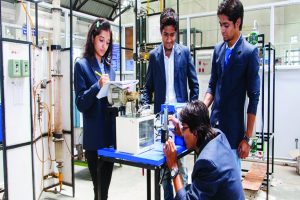 According to Kris Lakshmikanth, Founder Chairman and MD of The Head Hunters India, the curriculum involving quality technical education has not kept pace with the rapidly changing times and therefore vacancies can be hard to fill. Employability will improve when the syllabus reflects the demands of the industry.
According to Kris Lakshmikanth, Founder Chairman and MD of The Head Hunters India, the curriculum involving quality technical education has not kept pace with the rapidly changing times and therefore vacancies can be hard to fill. Employability will improve when the syllabus reflects the demands of the industry.
A Japanese firm that set up an ancillary unit in Karnataka approached Lakshmikanth for help with hiring CNC machine operators. “We can’t find five good candidates against the company’s requirement of 200. The skills required for the job are not taught in the five or six colleges,” he said. The employability issue will worsen as the years go by, as many jobs will be lost to robots, he added.
The incident reflects a misalignment between industry requirements and available resources, which is a major concern for recruiters across sectors. There seems to be an inherent disconnect between the curriculum based learning at the institution level, with the requisite ‘job ready’ skills needed by Indian corporates.
Since Independence, the technical education system in our country has grown into a fairly large-sized system, offering opportunities for education and training in a wide variety of trades and disciplines at a certificate, diploma, degree, postgraduate degree and doctoral levels in institutions located throughout the country.
The main objective of the technical education is that, it makes the students skilled and technically fit for the industries. In other words people with sound technical knowledge cannot remain unemployed.
A few observations seem pertinent. First, there has been increasing concern about the employment gap and skills gap. Second, more than half of India’s population of 1.3 billion is below the age of 25 and finally, the annual demand for new jobs in India is estimated at 12-15 million.
According to the All India Survey 2018 by the Association for Democratic Reforms (ADR) covering 534 Lok Sabha constituencies, spread among various demographics, ‘better employment opportunities’ tops the priorities of voters — it comes as no surprise though given the state of affairs.
“The single most important thing I find missing in our education system is its ability to help individuals understand why they are studying what they’re studying; what are their strengths and how can they impact society,” said Ketan Kapoor, CEO and co-founder, Mettl, an assessment and skill-measurement company. “The second reason is this culture of working really hard, to aim to be a perfectionist. It is important to understand that the student or the prospective employee is competing not just among peer groups in India but globally,” he added.
India has been witnessing the age of science and technology for long resulting in a huge demand of technical education. The pattern of life evolving in the age is very much different from the one we find in our society even some years back.
Technical education contributes immensely to the education system in general and plays an essential role in the social and economic development of our country. Besides, in this age of joblessness, only technical education can assure us of a good opportunity for employment and successful career.
However, country’s technical education is beset with many shortcomings. India’s predicament of substandard engineering education is now widely believed. It has left the engineers coming out of most of the Institutes almost unemployable. There have been some intermittent efforts to improve the situation but most of the efforts either fell short of desired level or failed to bring about any significant changes.
However, in order to scale up the overall technical education in the North Eastern Region a regional workshop of the Directors of Technical Education and Principals of polytechnic education of North Eastern Region was held recently (25-27 April, 2019) in Guwahati. It was hosted by Directorate of Technical Education, Assam under the aegis of National Institute of Technical Teachers’ Training & Research (NITTTR), Kolkata. As many as six Directors of Technical Education belonging to various states, 40 Principals of different Polytechnic colleges from North Eastern Region and faculties and experts from NITTTR attended the workshop.
NITTTR, Kolkata, was the first among four such institutes (other three being at Chandigarh, Bhopal & Chennai) established by the Dept. of Education, MHRD, Govt. of India as fully centrally funded autonomous institutions for providing pre & in-service training to the teachers and staff of Degree and Diploma level training institutions.
It’s also mandated for conducting various activities related to quality improvement of the technical education system of the country. The Govt of India, in 2003, accorded national status to this institute, (along with the three sister institutes) in recognition of the contribution of these institutes for the expert service rendered for overall improvement of quality of Technical Education System.
The 3-day workshop has been very methodically organized, with well-curated content. The workshop’s programme schedule set the tone for an atmosphere where people felt comfortable deliberating, expressing their thoughts and learning from one another. The individual participants brought to the fore significant issues ranging from shortage of faculties to lack of internet connection, from poor infrastructure to outdated laboratory equipments to severe supply shortage of electricity and water.
Although All India Council for Technical Education (AICTE) had assured to address some of the issues but the onus is on the state governments’ interventions. The economic development and growth of a nation depends largely on technical hands. And, therefore India is to more meaningfully prioritize quality technical education to boost the prosperity of the nation.
India is in an awful mess given that unemployability is a bigger worry than unemployment. Technology is changing at a brisk pace, so much so that it’s challenging to grasp. Thus realising the dream of modern India lies greatly with efficient ways of skilling, up-skilling and re-skilling of country’s rising youth population. The larger question is whether governments both at the centre and states will be able to crack the unemployability problem, or will the problem crack the governments.
letters@tehelka.com












